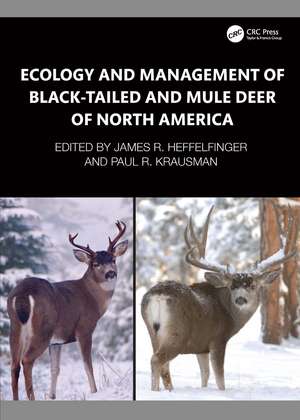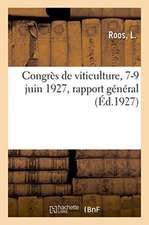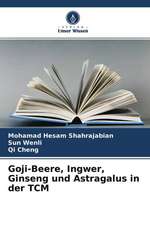Ecology and Management of Black-tailed and Mule Deer of North America
Editat de James R. Heffelfinger, Paul R. Krausmanen Limba Engleză Hardback – 27 apr 2023
The book represents all current knowledge available on these deer, including how changing conditions such as fires, habitat alteration and loss, disease, climate change, socio-economic forces, energy development, and other aspects are influencing their distribution and abundance now and into the future. It takes a completely fresh look at all chapter topics. The revisions of distribution, taxonomy, evolution, behavior, and new and exciting work being done in deer nutrition, migration and movements, diseases, predation, and human dimensions are all assembled in this volume.
This book will instantly become the foundation for the latest information and management strategies to be implemented on the ground by practitioners and to inform the public. Although this book is about deer, the topics discussed influence most terrestrial wildlife worldwide, and the basic concepts in many of the chapters are applicable to other species.
Preț: 877.73 lei
Preț vechi: 964.53 lei
-9% Nou
Puncte Express: 1317
Preț estimativ în valută:
167.97€ • 174.37$ • 140.06£
167.97€ • 174.37$ • 140.06£
Carte disponibilă
Livrare economică 01-15 martie
Livrare express 15-21 februarie pentru 72.01 lei
Preluare comenzi: 021 569.72.76
Specificații
ISBN-13: 9781032407609
ISBN-10: 1032407603
Pagini: 536
Ilustrații: 33 Tables, black and white; 20 Line drawings, color; 13 Line drawings, black and white; 82 Halftones, color; 11 Halftones, black and white; 102 Illustrations, color; 24 Illustrations, black and white
Dimensiuni: 210 x 280 x 31 mm
Greutate: 1.64 kg
Ediția:1
Editura: CRC Press
Colecția CRC Press
ISBN-10: 1032407603
Pagini: 536
Ilustrații: 33 Tables, black and white; 20 Line drawings, color; 13 Line drawings, black and white; 82 Halftones, color; 11 Halftones, black and white; 102 Illustrations, color; 24 Illustrations, black and white
Dimensiuni: 210 x 280 x 31 mm
Greutate: 1.64 kg
Ediția:1
Editura: CRC Press
Colecția CRC Press
Public țintă
Academic, Postgraduate, Professional Practice & Development, Professional Reference, and Undergraduate AdvancedCuprins
Section I. Biology and Ecology. 1. Origin, Classification, and Distribution. 2. Historical Trends in Black-Tailed Deer, Mule Deer, and their Habitats. 3. Physical Characteristics. 4. Digestive Physiology and Nutrition. 5. Modeling Population Dynamics of Black-tailed and Mule Deer. 6. Diseases and Parasites. 7. Carnivore-Prey Relationships. 8. Competition with Other Ungulates. Section II. Ecoregion Habitats and Population Dynamics. 9. Northern Forest Ecoregion. 10. Coastal Rainforest Ecoregion. 11. Intermountain West Ecoregion. 12. Great Plains Ecoregion. 13. California Chaparral and Oak Woodlands Ecoregion. 14. Southwest Deserts Ecoregion. 15. Colorado Plateau Shrubland and Forest Ecoregion. Section III. Population Management. 16. Population Monitoring. 17. Harvest Management. 18. Human Dimensions. Section IV. Habitat Management. 19. Conflict Management. 20. Threats to Habitat Function. 21. Habitat Improvement and Water Supplementation. 22. Migration. Section V. The Future. 23. Challenges and Opportunities for the Future Conservation of Black-Tailed and Mule Deer.
Notă biografică
James R. Heffelfinger is Wildlife Science Coordinator for Arizona Game and Fish Department and Full Research Scientist in the School of Natural Resources and the Environment at University of Arizona, Tucson. For the last 17 years, he has served as Chairman of the Mule Deer Working Group sponsored by the Western Association of Fish and Wildlife Agencies. This working group consists of the leading black-tailed or mule deer expert from each of 24 states, provinces, and territories in western North America. James is a Certified Wildlife Biologist, and recipient of the O. C. “Charlie” Wallmo Award for contributions to black-tailed and mule deer knowledge and conservation in North America, Mule Deer Foundation’s Professional of the Year Award, Lee Gladfelter Memorial Award, and Distinguished Alumnus University of Wisconsin – Stevens Point. He has authored and coauthored >65 scientific papers, 29 book chapters, 295 magazine articles, several TV scripts, and the book Deer of the Southwest published by Texas A&M University Press.
Paul R. Krausman is Professor Emeritus from the School of Natural Resources and the Environment, University of Arizona, Tucson. Paul is a Certified Wildlife Biologist, Wildlife Fellow, Honorary Member of The Wildlife Society, and served as faculty advisor for the student chapters of The Wildlife Society at Auburn, Arizona, and Montana. He has served as editor, associate editor, and guest editor for numerous scientific outlets. Paul has published 41 book chapters, 14 books, >100 conference proceedings, and >270 peer-reviewed monographs and manuscripts. He has received numerous awards for his teaching and research including the O. C. “Charlie” Wallmo Award (1999), the Desert Ram Award (2000), and the Aldo Leopold Memorial Award (2006).
Paul R. Krausman is Professor Emeritus from the School of Natural Resources and the Environment, University of Arizona, Tucson. Paul is a Certified Wildlife Biologist, Wildlife Fellow, Honorary Member of The Wildlife Society, and served as faculty advisor for the student chapters of The Wildlife Society at Auburn, Arizona, and Montana. He has served as editor, associate editor, and guest editor for numerous scientific outlets. Paul has published 41 book chapters, 14 books, >100 conference proceedings, and >270 peer-reviewed monographs and manuscripts. He has received numerous awards for his teaching and research including the O. C. “Charlie” Wallmo Award (1999), the Desert Ram Award (2000), and the Aldo Leopold Memorial Award (2006).
Recenzii
This is not a book to be kept on a shelf for occasional, casual reading, nor can it be used effectively as a textbook on which to base an undergraduate or graduate course. Ecology and Management of Black‐Tailed and Mule Deer of North America is a comprehensive compilation of everything currently known about black‐tailed and mule deer. As such, it will be an invaluable resource for anyone with an interest in this iconic species. Graduate students
needing to brush up on basic life‐history traits of mule or black‐tailed deer will find everything they need to know in these pages. Biologists and managers wanting to implement new strategies for monitoring deer populations or for modifying deer habitat will find clear, accessible guidance. Even non‐professionals will find this a useful reference. This is the bible for anyone interested in mule or black‐tailed deer, and I know my copy won't just sit on my shelf.
Ryan A. Long, Department of Fish and Wildlife Sciences, University of Idaho, Moscow, Idaho, USA
Representing three subspecies of Odocoileus hemionus, black-tailed and mule deer are the iconic deer of western North America. Significant culturally, historically, economically, and spiritually, these deer have drawn a significant amount of attention in both technical and popular outlets. Until now, the most comprehensive volume on these deer was Mule and Black-Tailed Deer of North America, compiled and ed. by Olof Wallmo (1981), comprising 15 essays by 12 contributors. In the 40-years since 1981 much has changed and much has been learned. Wildlife scientists and managers have long been concerned over the steady decline in mule deer populations. Heffelfinger and Krausman, both respected experts, brought together 15 essays by a total of 82 authors. Readers at all levels, whether scientists, wildlife managers, students, or wildlife enthusiasts, will find this book readable yet packed with the most current science and technical information. Examples of topics represented in the present volume but not in the earlier book include chronic wasting disease, migration ecology, integrated population modeling, genetics, and finer treatments of ecoregional differences. The editors' care with this volume is evident throughout. It will be the definitive reference for this species.
-J. Organ, Emeritus, University of Massachusetts Amherst
needing to brush up on basic life‐history traits of mule or black‐tailed deer will find everything they need to know in these pages. Biologists and managers wanting to implement new strategies for monitoring deer populations or for modifying deer habitat will find clear, accessible guidance. Even non‐professionals will find this a useful reference. This is the bible for anyone interested in mule or black‐tailed deer, and I know my copy won't just sit on my shelf.
Ryan A. Long, Department of Fish and Wildlife Sciences, University of Idaho, Moscow, Idaho, USA
Representing three subspecies of Odocoileus hemionus, black-tailed and mule deer are the iconic deer of western North America. Significant culturally, historically, economically, and spiritually, these deer have drawn a significant amount of attention in both technical and popular outlets. Until now, the most comprehensive volume on these deer was Mule and Black-Tailed Deer of North America, compiled and ed. by Olof Wallmo (1981), comprising 15 essays by 12 contributors. In the 40-years since 1981 much has changed and much has been learned. Wildlife scientists and managers have long been concerned over the steady decline in mule deer populations. Heffelfinger and Krausman, both respected experts, brought together 15 essays by a total of 82 authors. Readers at all levels, whether scientists, wildlife managers, students, or wildlife enthusiasts, will find this book readable yet packed with the most current science and technical information. Examples of topics represented in the present volume but not in the earlier book include chronic wasting disease, migration ecology, integrated population modeling, genetics, and finer treatments of ecoregional differences. The editors' care with this volume is evident throughout. It will be the definitive reference for this species.
-J. Organ, Emeritus, University of Massachusetts Amherst
Descriere
This book represents all current knowledge available on these deer, including how changing conditions such as fires, habitat alteration and loss, disease, climate change, socio-economic forces, energy development, and other aspects are influencing their distribution and abundance now and into the future.










